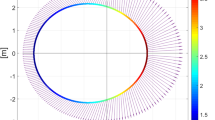Abstract
Spacecrafts with the pure gravity environment are of great significance in precision navigation, gravity field measurement for celestial bodies, and basic physics experiments. The radiometer effect is one of the important interfering factors on the proof mass in a purely gravitational orbit. For the gravity field measurement system based on the inner-formation flying, the relationship between the radiometer effect on the innersatellite and the system parameters is studied by analytical and numerical methods. An approximate function of the radiometer effect suitable for the engineering computation and the correction factor are obtained. The analytic results show that the radiometer effect on the inner-satellite is proportional to the average pressure while inversely proportional to the average temperature in the outer-satellite cavity. The radiometer effect increases with the temperature difference in the cavity, and its minimum exists when the cavity radius increases. When the minimum of the radiometer effect arrives, the ratio of the cavity radius to the inner-satellite radius is 1.189 4. This constant is determined by the spherical cavity configuration and independent of the temperature and pressure distributions. When the ratio of the cavity radius to the inner-satellite radius is more than 10, it is believed that the cavity is large enough, the radiometer effect is approximately proportional to the square of the inner-satellite radius, and the influence of the outer-satellite cavity radius on the radiometer effect can be ignored.
Similar content being viewed by others
References
DeBra, D. B. Drag-free control for fundamental physics missions. Advance in Space Research, 32(7), 1221–1226 (2003)
Staff of the Space Departacent of the Applied Physics Laboratery of Johns Hopkins University and Staff of the Guidance and Control Laboratory of Stanford University. A satellite free of all but gravitational forces: “TRIAD-I”. Journal of Spacecraft and Rockets, 11(9), 637–644 (1974)
Sumner, T. J., Anderson, J., Blaser, J. P., Cruise, A. M., Damour, T., Dittus, H., Everitt, C. W. F., Foulon, B., Jafry, Y., Kent, B. J., Lockerbie, N., Loeffler, F., Mann, G., Mester, J., Pegrum, C., Reinhardt, R., Sandford, M., Scheicher, A., Speake, C. C., Torii, R., Theil, S., Touboul, P., Vitale, S., Vodel, W., and Worden, P. W. Satellite test of the equivalence principle. Advance in Space Research, 39(2), 254–258 (2007)
Mester, J., Torii, R., Worden, P., Lockerbie, N., Vitale, S., and Everitt, C. W. F. The STEP mission: principles and baseline design. Classical and Quantum Gravity, 18, 2475–2486 (2001)
Bonny, L. S. Disturbance reduction requirements for LISA. Classical and Quantum Gravity, 20, 239–253 (2003)
Ni, W. T., Shiomi, S., and Liao, A. C. ASTROD, ASTROD-I and their gravitational-wave sensitivities. Classical and Quantum Gravity, 21, 641–646 (2004)
Ni, W. T. ASTROD (astrodynamical space test of relativity using optical devices) and ASTROD I. Nuclear Physics B, 166, 153–158 (2007)
Muzia, D. and Allasio, A. GOCE: the first core Earth explorer of ESA’s Earth observation programme. Acta Astronautica, 54(3), 167–175 (2003)
Liu, H. W., Wang, Z. K., and Zhang, Y. L. Coupled modeling and analysis of radiometer effect and residual gas damping on proof mass in purely gravitational orbit (in Chinese). Scientia Sinica Technologica, 54, 894–902 (2011)
Shiomi, S. and Ni, W. T. Acceleration disturbances and requirements for ASTROD I. Classical and Quantum Gravity, 23, 4415–4432 (2006)
Liu, H. W., Wang, Z. K., and Zhang, Y. L. Modeling and analysis of radiometer effect on the inner-satellite (in Chinese). Chinese Journal of Space Science, 30(3), 243–249 (2010)
Author information
Authors and Affiliations
Corresponding author
Additional information
Project supported by the National Natural Science Foundation of China (No. 11002076) and the National Defence Preresearch Foundation of China (No. 51320010201)
Rights and permissions
About this article
Cite this article
Liu, Hw., Wang, Zk. & Zhang, Yl. Analysis of radiometer effect on proof mass in purely gravitational orbit. Appl. Math. Mech.-Engl. Ed. 33, 583–592 (2012). https://doi.org/10.1007/s10483-012-1572-8
Received:
Revised:
Published:
Issue Date:
DOI: https://doi.org/10.1007/s10483-012-1572-8




